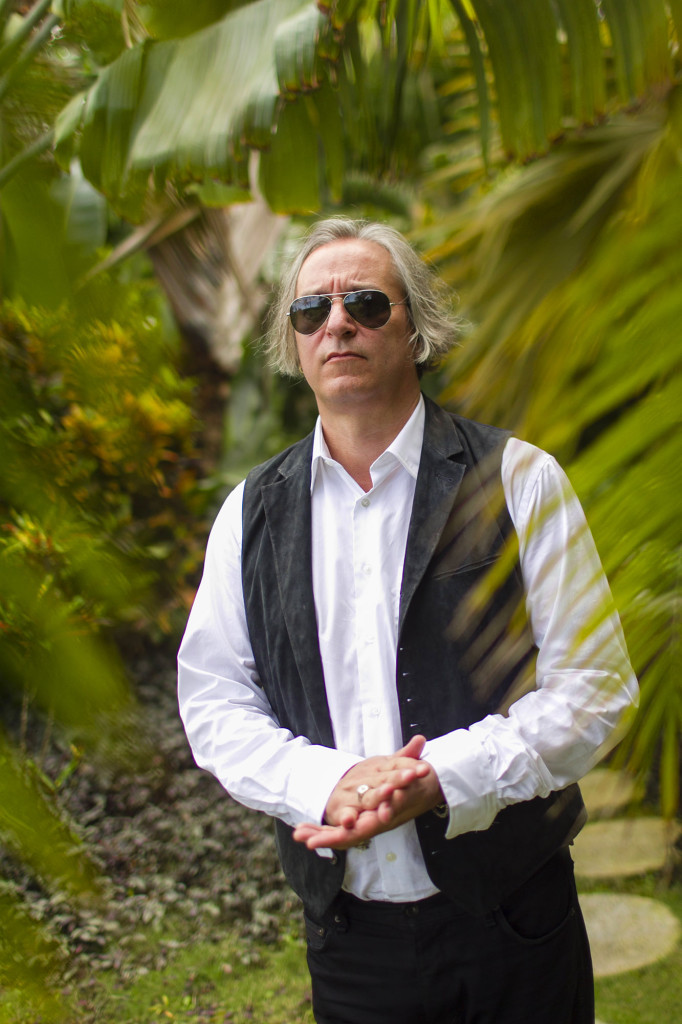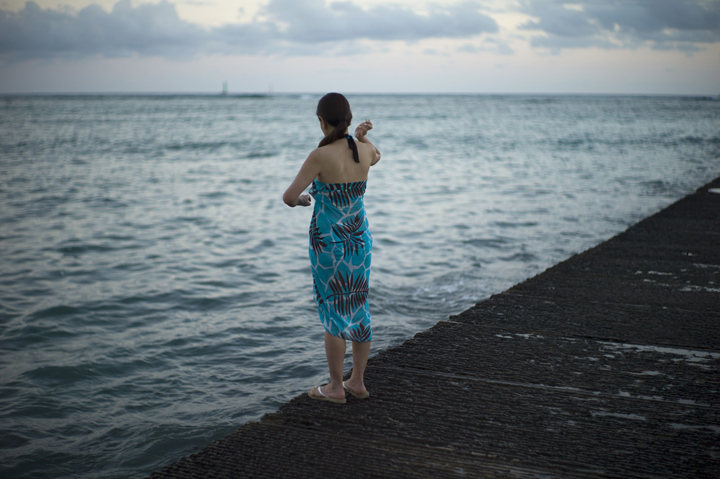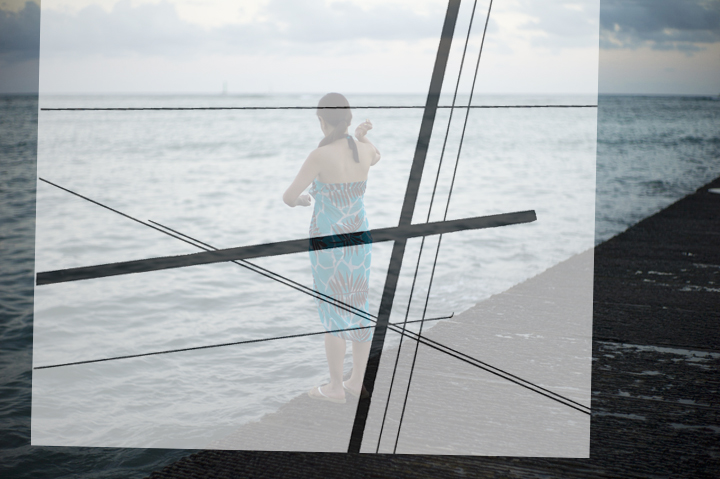This past New Year’s Eve, I had the incredible opportunity to photograph R.E.M.’s legendary guitarist Peter Buck for the Wall Street Journal at his beachfront home in Kauai. The WSJ needed a last minute portrait of the musician to illustrate their story about him that was slated to publish in early January. Peter was scheduled to be out of the country during the upcoming weeks so this was the only time that I had to capture him before he left.
R.E.M. was on my music rotation as a high school kid in the 1980s. I had their earlier albums and thought I was a postmodern hipster who listened to the classics and not the bland top 40 hits. “Radio Free Europe,” “Fall on Me” and many of their other early 80’s hits were duly scratched up on their respective vinyl. I never really cared for folk rock at the time but tolerated Michael Stipe’s whine and loved their distinct sound. It wasn’t until their 1991 release of their Out of Time album that they skyrocketed to MTV fame and constant radio play.
I was already in college when that album was released. We’d mimic Stipe’s quirky dancing and sang along poorly, mostly due to the copious amounts of cheap beer, to “Losing my Religion” and the other hits on the album. Kate Pierson harmonics dominated “Shiny Happy People” but it was Peter Buck’s melodic mandolin that sold LMR to the masses. His 16th century sound just entranced us listeners and the lyrics, along with the video, made for a Rembrandt visual along with a poetic moment.
So on the days leading up to the assignment, I told some of my friends about my job but tried not to gush too much about my excitement of photographing Peter. It is never good to get too star struck before a job.
After landing in Kauai, I worried Peter would be slightly aloof and irritable as it was New Years Eve but we had no other choice. I had scheduled only a few hours for the job, including my travel time, to ensure I wouldn’t encroach on his personal time. And as I drove into his neighborhood on the north side of Kauai, I became slightly lost in the rural beach community. In an earlier email Peter sent me, he stated his property might be hard to find. So with a little embarrassment, I called him stating my predicament and asked for directions. And as I did a U-turn and slowly drove down the nearly deserted sandy beach road, there stood Peter Buck on his cell phone, wearing dark glasses and waving at me.
He warmly invited me into his home and we small talked as I prepared my cameras and lighting gear. He had that cool rock vibe, and definitely no attitude. He wore artist black and seemed out of place on Kauai where bright aloha shirts and board shorts are the norm but he stayed true to his rock star status. At first he appeared slightly apprehensive, as we had never worked together. But after chatting for a few minutes about my work, I could see that he developed a trust that I would get it right.
I quickly photographed him on the beach, near some mangroves down near his house, and in his garden. We also had time for a few shots of him and his lovely wife. The photo I loved most was taken on the beach where he stood with his ankles crossed. It reminded me of those music videos or live concerts where he played and stood in a similar pose. The picture turned into one of those memories from a time long passed that returns to the present.
Our last shot turned out to be the best. The tropical foliage swirled around him in this beautiful bokeh and he exuded this confidence that he developed spending nearly a life time on stage in front of thousands. The WSJ chose that shot to illustrate the story.

During our shoot, Peter and I chatted about all sorts of things including the capriciousness of our businesses and how he’d have a tough time now recommending music as a full time career. Digital has made the tough business of music tougher. Photography isn’t any different. It is tough to be a Peter Buck these days, and in some ways, it can be tough to be me. He told me about his huge collection of African and gospel music on vinyl, talked about spending time living om Kauai, and eating Mexican food at Monico’s Taqueria in Kapa’a just down the road. Peter did tell me it was nice to spend time on Kauai where people rarely recognized him.
Peter and his wife were really nice to be around. I never figured I’d have alone time with someone whose CD’s and albums were scratched to hell from being played, stolen, and lost behind the bookshelf. I can’t say he meant as much to me as being around someone like The Edge or John Taylor but he’s definitely up there as rock stars go. His signature guitar style defined R.E.M. through the 80’s and 90’s. His legacy will last for a really long time. I sadly didn’t have any R.E.M. paraphernalia for him to sign but it didn’t matter, as my photographs became my proof of his existence. Our selfie didn’t hurt either. On a funny note, I can’t remember if I had ever seen R.E.M. live. I bothered my pal Diego about this and he claims I must have seen them in either Austin or San Antonio. I really can’t remember but if he says so…then it must be true.
As I left his house and headed back to Lihue, I felt relieved our job went well. There’s lots of pressure to produce a great portrait and without a budget for an assistant, its all up to me to make it happen. I felt I had accomplished my goal in that short window of time but wouldn’t know till I edited the job.
I did leave some time for a quick bite at Monico’s on the way back to the airport but they were closed for the holiday! They have some of the best Mexican food in Hawaii and I just could not understand why a restaurant with insanely good margaritas would be closed on New Years Eve. Hence, I had no celebratory limey cocktail to enjoy my elation of photographing a rock star. As I sadly drove back to the airport on an empty stomach, the radio blasted ‘It’s The End Of The World As We Know It (And I Feel Fine.)” I took it as an omen and I texted Peter of my bad luck with Monico’s but of my rapture in hearing their classic song. But T Mobile sucks in many parts of Kauai and I had no signal. Yet it didn’t matter. The R.E.M. song reaffirmed my success and I once again sang along, poorly but without booze, to their song as I soared back to LIH.
 Kahala Life, the in-house magazine at the Kahala Resort, had me photograph Austin Kino and his boat on Kahala Beach several weeks back. Needless to say, it was an easy job as it took about two tries. Austin, who runs the concession sailing business on the property, is also a model and made it look good. Austin is also a navigator on the Hokulea and he told us about his time on the historic boat.
Kahala Life, the in-house magazine at the Kahala Resort, had me photograph Austin Kino and his boat on Kahala Beach several weeks back. Needless to say, it was an easy job as it took about two tries. Austin, who runs the concession sailing business on the property, is also a model and made it look good. Austin is also a navigator on the Hokulea and he told us about his time on the historic boat.





